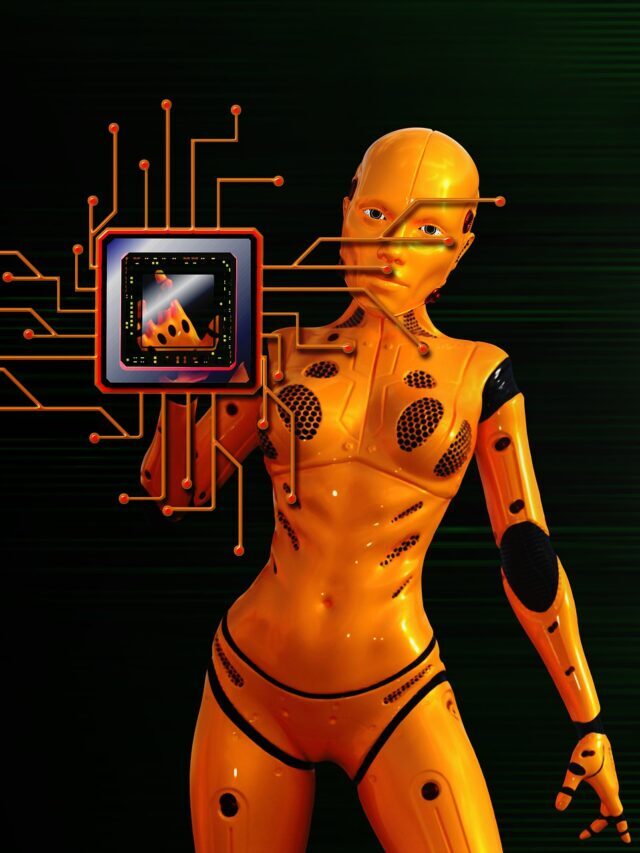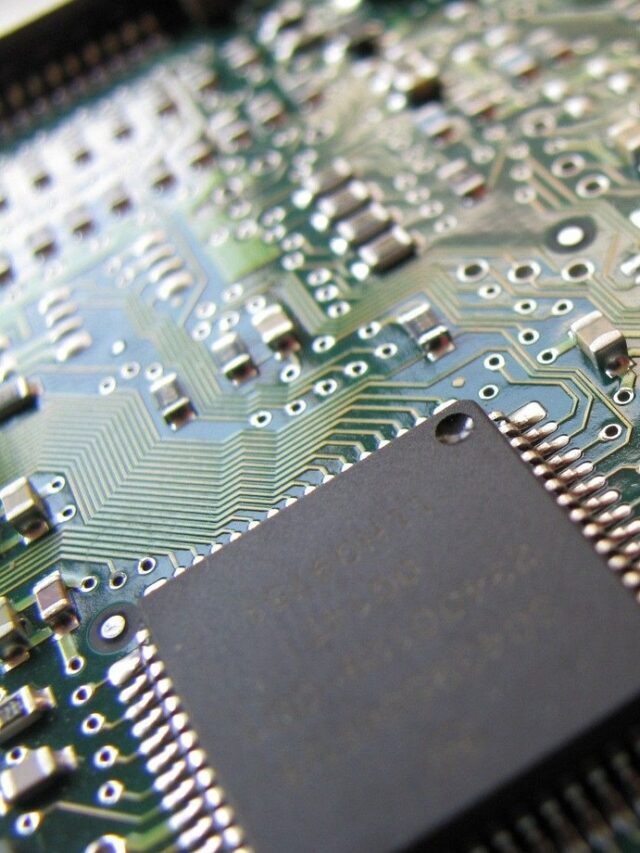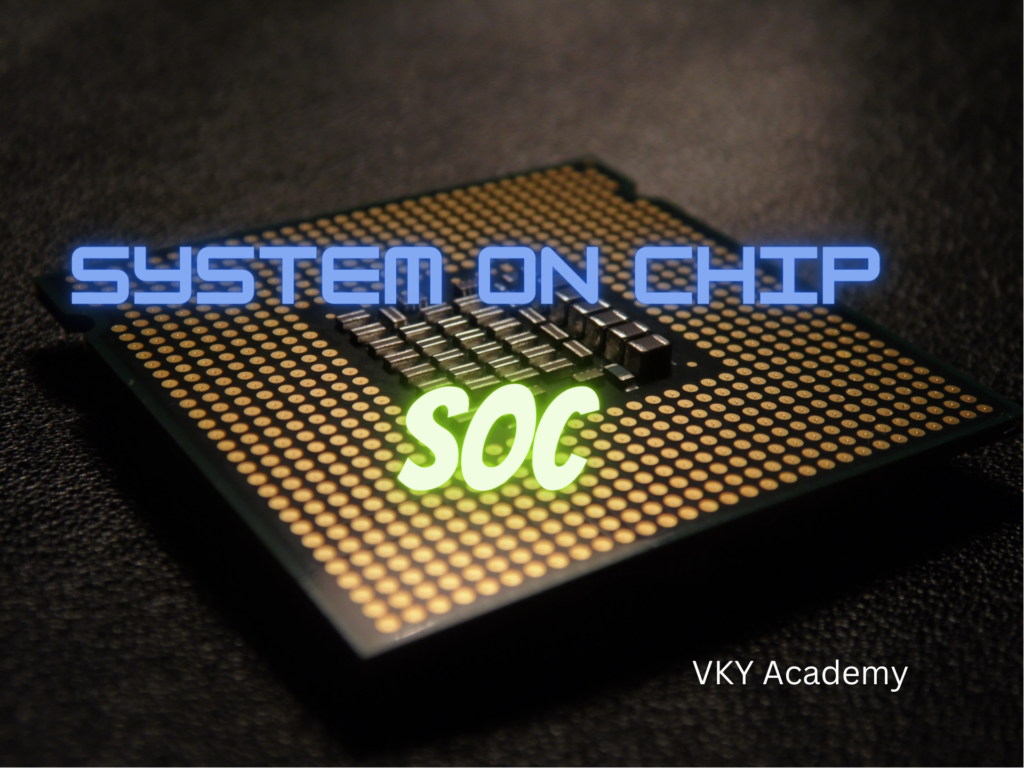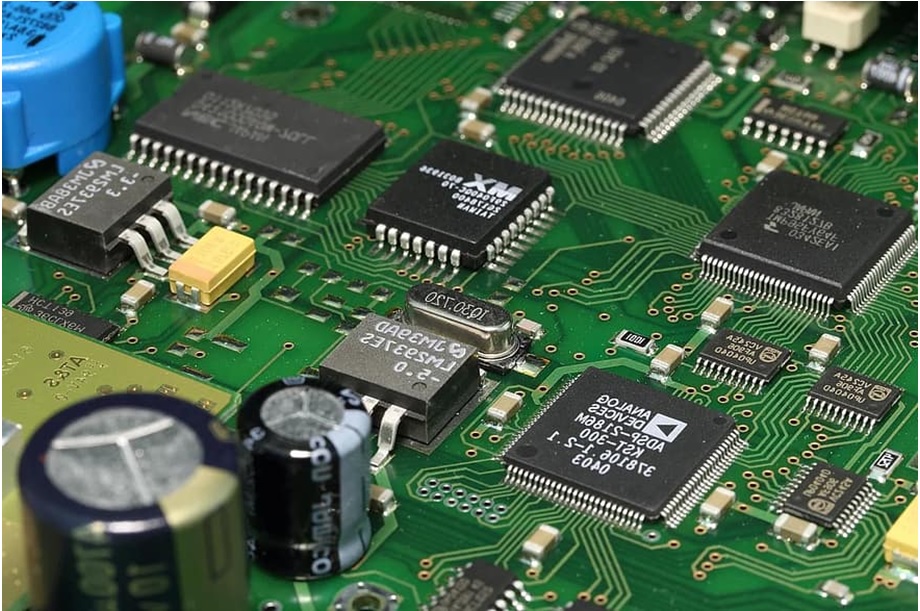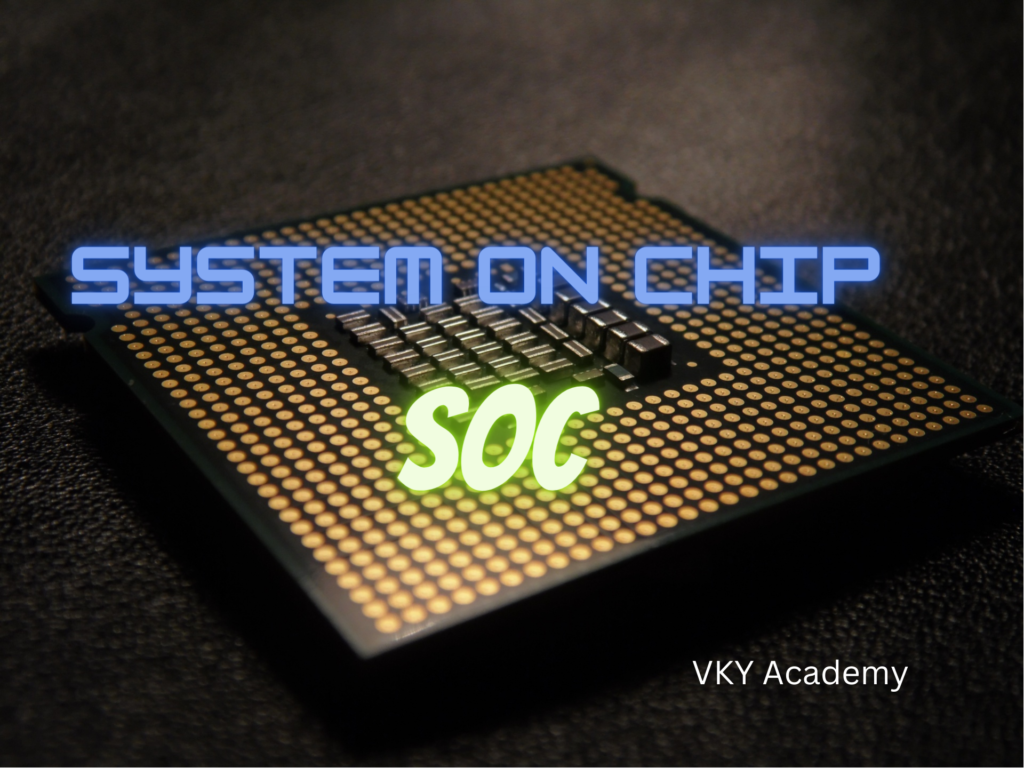
Introduction:
The world of electronics has experienced a remarkable transformation with the advent of System on Chip (SoC) technology. These highly integrated circuits have revolutionized the way electronic systems are designed, offering unprecedented levels of performance, power efficiency, and miniaturization. In this comprehensive article, we will explore the intricacies of SoCs, their components, applications, and the impact they have had on various industries. So, let’s dive in and unravel the wonders of System on Chip technology.
Also Read VLSI and Embedded System Jobs Interview Question Series : https://vkyacademy.com/interview-questions/
Understanding System on Chip (SoC):
At its core, a System on Chip is an integrated circuit that encompasses a wide range of functional components required to build a complete electronic system.

Unlike traditional motherboard-based architectures, where components are separated and connected through a central circuit board, SoCs consolidate various components onto a single chip. This integration results in compact, efficient, and cost-effective systems that offer enhanced performance and reduced power consumption.
Components of SoC :
A typical SoC comprises several key components, each serving a specific purpose. Let’s take a closer look at these components:

- Processor Cores:
The processor core is the heart of an SoC, which can include microcontrollers, microprocessors, digital signal processors (DSP), or application-specific instruction set processors (ASIP). These cores handle the execution of software code and enable the SoC to perform complex calculations and tasks. - Memory Capabilities:
SoCs incorporate various memory capabilities, such as RAM, ROM, FLASH, EEPROM, and cache memory. These memory modules store and retrieve data, instructions, and firmware required for the proper functioning of the system. - External Interfaces:
SoCs feature external interfaces that facilitate communication with other devices. These interfaces support wired communication protocols like HDMI, USB, FireWire, USART, SPI, I²C, and Ethernet, enabling seamless connectivity with external peripherals. - Wireless Capabilities:
With the rise of wireless communication, SoCs are equipped with wireless capabilities like WiFi, Bluetooth, and other radio frequency functionalities. These wireless features enable connectivity with other devices and networks, enhancing the overall versatility of the system. - Graphical Processing Unit (GPU):
SoCs often include a dedicated Graphics Processing Unit (GPU) to accelerate graphics rendering and perform complex visual computations. This GPU enhances the system’s ability to handle graphics-intensive tasks, making it ideal for applications like gaming and multimedia. - Voltage Regulators and Control Systems:
SoCs incorporate voltage regulators and phase lock loop (PLL) control systems to ensure stable power supply and clock synchronization. These components optimize the system’s performance and reduce power consumption. - Intrachip Communication Subsystems:
To enable seamless communication between different circuit blocks, SoCs incorporate intrachip communication subsystems. These can be interface buses or advanced intercommunication networks known as networks-on-chip (NoC), facilitating efficient data transfer and coordination. - Digital, Analog, and Mixed-Signal Processing Circuit Blocks:
SoCs integrate digital, analog, and mixed-signal processing circuit blocks to support sensors, actuators, data collection, and data analysis. These blocks enable the SoC to process and interpret various types of signals and facilitate interaction with the external environment.
With these diverse components, SoCs offer a versatile platform that powers the next generation of electronic devices and systems.
Applications of System on Chip (SoC) :
The versatility and compact nature of SoCs have led to their widespread adoption in various fields. Let’s explore some of the major applications of SoCs:
- Mobile Computing :
SoCs have played a pivotal role in the mobile computing revolution, powering devices such as smartphones, tablets, and smartwatches.

These compact chips provide the necessary computing power, memory, wireless capabilities, and graphical processing required for advanced mobile applications. SoCs have enabled the development of high-performance, energy-efficient mobile devices that fit comfortably in the palm of our hands.
- Embedded Systems :
Embedded systems, where previously only microcontrollers were utilized, have witnessed a significant shift towards the adoption of SoCs.

The tight integration offered by SoCs enhances system reliability, mean time between failures, and overall functionality. SoCs are extensively employed in applications such as AI acceleration, machine vision, data collection, telemetry, vector processing, and ambient intelligence. They have become the go-to choice for IoT devices, industrial automation, and edge computing solutions.
- Personal Computers and Laptops :
SoCs are not limited to mobile and embedded systems; they have also found their way into personal computers and laptops.

In recent years, manufacturers have realized the benefits of reduced power consumption and improved performance achieved through SoC integration. By consolidating multiple components onto a single chip, SoCs minimize circuit real estate, resulting in reduced heat generation and optimized power consumption.
This has paved the way for more efficient device designs, better heat distribution, minimal latency, and accelerated data transmission.
- Custom SoCs for Advanced Applications :
Recognizing the unique requirements of certain applications, companies are increasingly investing in the development of custom SoCs.

The above image is the Neuromorphic NeuRRAM Chip for AI Developed, Performs Computations in Memory Without Network Connectivity.
These specialized SoCs are tailored to specific domains, such as machine learning, advanced AI capabilities, and high-performance computing. By leveraging the distributed operation capabilities of SoCs, companies can achieve faster data processing, enhanced parallelism, and improved computational efficiency.
Custom SoCs empower businesses to meet the demands of advanced data and signal processing, propelling innovation in diverse industries.
The applications of SoCs extend beyond the aforementioned fields, branching into sectors like automotive, aerospace, healthcare, and consumer electronics. The flexibility and adaptability of SoCs make them an ideal choice for a wide range of applications.
The Future of System on Chip (SoC) :
As technology continues to advance, SoCs will play an increasingly vital role in shaping the future of electronics. The ongoing trend of tighter integration in the semiconductor industry, driven by the influence of SoCs, has paved the way for embedded computing and hardware acceleration.
The relentless pursuit of energy efficiency, cost reduction, and miniaturization has led to continuous innovation in SoC design and development.
With each passing year, we can expect to witness even more powerful and efficient SoCs, capable of handling complex computational tasks while minimizing energy consumption.
The integration of advanced technologies like artificial intelligence, machine learning, and high-performance computing into SoCs will unlock new possibilities and revolutionize various industries.
In conclusion, System on Chip technology has transformed the world of electronics, enabling the creation of compact, power-efficient, and high-performance devices.
From smartphones to embedded systems, SoCs have become the backbone of modern technology. As we look ahead, the future of SoCs holds immense potential, promising further advancements in computing power, energy efficiency, and customization. SoC technology is here to stay, driving innovation, and shaping the future of electronics.
